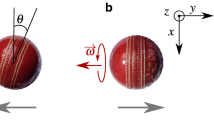Abstract
The impact location of a cricket ball on a cricket bat has a large influence on the resulting rebound velocity of the ball. To measure this, a cricket bat was swung in a pendulum motion towards a cricket ball suspended in space. The position of the ball was modified so that it impacted the bat at 24 different positions on the face of the bat. This included six positions longitudinally and four positions laterally. The speed of the bat and each rebound were measured by a radar gun so that the apparent coefficient of restitution (ACOR) could be calculated. Impacts occurring centrally and 1 cm either side of the midline produced significantly higher rebound speeds and ACOR’s than impacts occurring 2 and 3cm off centre (p < 0.01). Impacts occurring 15–20 cm from the base of the bat produced the highest rebound speeds (p < 0.01) and impacts occurring 20–30 cm from the base of the bat produced the highest ACOR values. Implications for higher speed impacts and game scenarios are discussed.


Similar content being viewed by others
References
Bower RG, Sinclair P (2007) Tennis racket stiffness, string tension and impact velocity effects on post-impact ball angular velocity. Sports Eng 10:111–122
Brooks R, Mather J, Knowles S (2006) The influence of impact vibration modes and frequencies on cricket bat performance. Proceedings of the Institution of Mechanical Engineers 220(4):237–248
Brody H (1979) Physics of the tennis racquet. Am J Phys 47(6):482–487
Brody H (1981) Physics of the tennis racquet II: the “sweet spot”. Am J Phys 49(9):816–819
Brody H (1986) The sweet spot of a baseball bat. Am J Phys 54(7):640–643
Carre M, James D, Haake S (2004) Impact of a non-homogenous sphere on a rigid surface, proceedings of the Institution of Mechanical Engineers. J Mech Eng Sci 218(3):273–281
Cohen J (1992) Statistical power analysis. Curr Dir Psychol Sci 1(3):98–101
Cross R (1997) The dead spot of a tennis racket. Am J Phys 65(8):754–764
Cross R (1998) The sweet spot of a baseball bat. Am J Phys 66(9):772–779
Cross R (2003) Oblique impact of a tennis ball on the strings of a tennis racket. Sports Eng 6(4):235–254
Cross R, Nathan A (2009) Performance versus moment of inertia of sporting Implements. Sports Technol Rev 2(1–2):7–15
Elliott B, Ackland T (1982) Physical and impact characteristics of aluminium and wooden cricket bats. J Hum Mov Stud 8:149–159
Gutaj F (2004) A comparison of methods for modelling the dynamics of a cricket bat. J Mech Eng Sci 218(12):1457–1468
Haake S, Allen T, Choppin S, Goodwill S (2007) The evolution of the tennis racket and its effect on serve speed. In: Tennis Science and Technology 3, vol 1. International Tennis Federation, London, pp 257–271
Hatze H (1992) Objective biomechanical determination of tennis racquet properties. Int J Sport Biomech 8:275–287
John S, Li Z (2002) Multi-directional vibration analysis of cricket bats, Engineering of Sport 4, Blackwell Science Ltd, Oxford, pp 96–103 (ISBN: 0-632-06481-1)
Knowles S, Mather J, Brooks R (1996) Cricket bat design and analysis through impact vibration modelling. In: Haake (ed) The Engineering of Sport, Balkema, Rotterdam
Miller S (2006) Modern tennis rackets, balls and surfaces. Br J Sports Med 40:401–405
Nathan A (2000) Dynamics of the baseball–bat collision. Am J Phys 68(11):979–990
Stretch R, Brink A, Hugo J (2005) A comparison of the ball rebound characteristics of wooden and composite cricket bats at three approach speeds. Sports Biomech 4(1):37–45
Author information
Authors and Affiliations
Corresponding author
Rights and permissions
About this article
Cite this article
Bower, R. The sweet spot of a cricket bat for low speed impacts. Sports Eng 15, 53–60 (2012). https://doi.org/10.1007/s12283-012-0087-6
Published:
Issue Date:
DOI: https://doi.org/10.1007/s12283-012-0087-6




